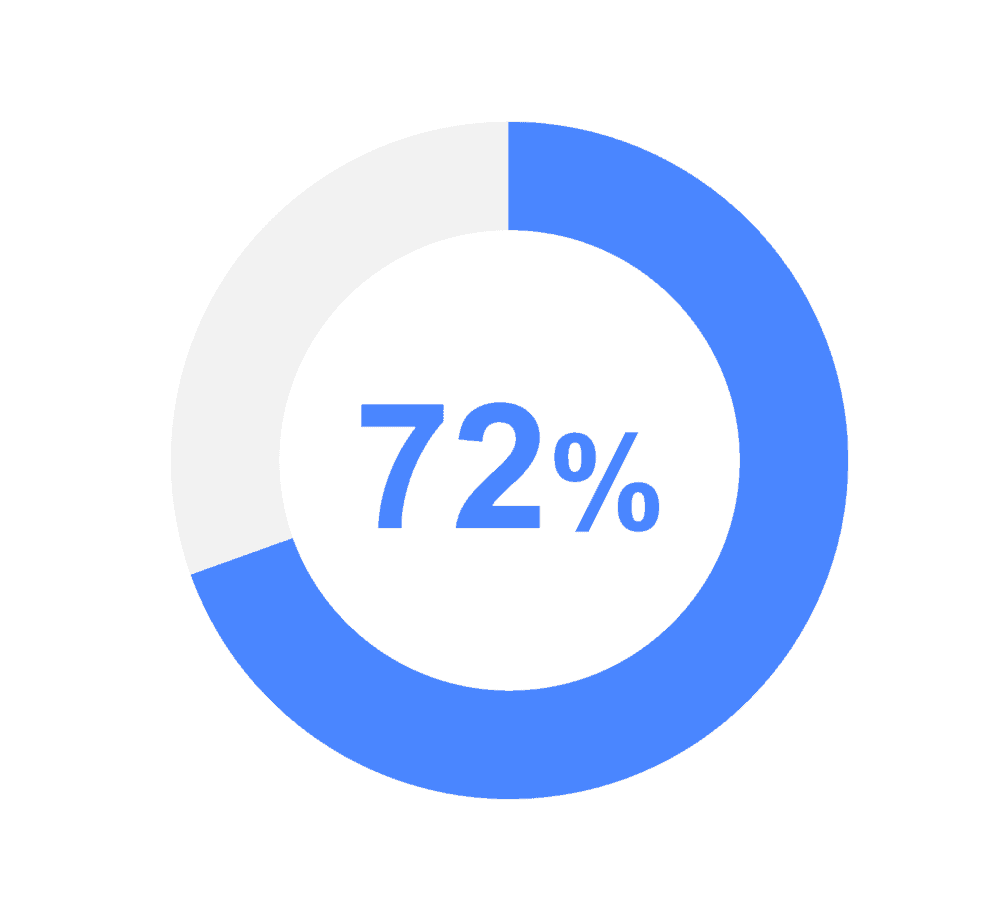Our content is reader supported, which means when you buy from links you click on, we may earn a commission.
18 Mobile Learning Trends and Statistics

Creating eLearning materials is both time and resource-consuming. You don’t want to waste time which is why it’s worth it to take into account user experience before you develop any of your course content.
To develop effective and user-friendly training, you must first understand how modern learners interact with eLearning materials.
This knowledge will allow you to design training programs that are targeted and optimized for your users. Since there’s a steady increase in the use of mobile devices, it’s important to factor this into your instructional design process.
Here are the top mobile learning statistics and trends that can help guide your online training creation process.
Mobile Learning Statistics
People love their smartphones which is why mobile technology is on the rise.
Let’s start with mobile learning statistics so you can see just how much potential this segment of the online learning marketplace has.
1. Sixty-Four Percent of Participants Place Importance on Mobile Device Accessibility
 The reality is users want to access online training material through their mobile devices. While most tools allow access to online learning platforms, developers don’t always do enough to optimize them for mobile devices.
The reality is users want to access online training material through their mobile devices. While most tools allow access to online learning platforms, developers don’t always do enough to optimize them for mobile devices.
Training programs tend to be confusing, slow, unorganized, and unoptimized for smaller screens. As a result, it discourages users from accessing the training material through their smartphones. So it’s wise to pay attention to how your training works on mobile and spend some time optimizing it for them there.
Your users want to access your training on the go, from their phones, so make it easy for them.
2. Mobile Learning Results in a 72% Increase in User Engagement
Did you know that users reported a 72 percent increase in engagement with mobile learning?
The challenge often lies in trying to get users to participate and finish training material as soon as possible. Higher engagement means more training efficiency for companies and organizations.

3. eLearning Needs to Be Built for All Types of Users to Increase Productivity
Many online training programs focus only on desktop users. But it’s essential to make sure that your online training program supports multiple devices, including desktop, tablets, and smartphones. Mobile users saw a 43 percent improvement in their productivity compared to desktop users.
And you can’t overlook the fact that most eLearning users own multiple devices now. Ideally, they’d like to complete some of your training program on their laptop and then seamlessly switch over to mobile on the go when they have some spare time.

4. Offering Flexibility is Key
Users want more flexibility when it comes to eLearning. They want to be able to login to the training program no matter the device. They want to be able to learn on their schedule.
Forty-six percent of learners use mobile learning on their devices before they go to sleep at night. You want to empower users to learn on their lunch breaks, commute, travels, and downtime by merely making the training available on a mobile device.

5. More Companies are Adopting BYOD Policies
Security is an essential issue for many companies and organizations. But to make it easier for users to access online education platforms, the information is stored apart from other databases.
Companies and organizations are adopting BYOD (bring your device) policies. These policies correlate to the trend of 70 percent of professionals taking care of work issues using their mobile devices.

6. Mobile Learning Solutions Saves Money and Has a Strong ROI
Statistics show that every dollar invested into eLearning in corporations translated to $30 in increased productivity.
Companies that implement eLearning have a 26 percent higher revenue generated per employee figures. Based on all the other studies and statistics, the adoption of mobile eLearning can improve these numbers even further.

Mobile Learning Trends
There are a lot of trends in eLearning. Many of them fall into the mobile eLearning segment.
Here are the biggest mobile learning trends to be on the look-out for. Some may even turn into best practices in the near future.
7. Microlearning Offers Faster Learning and Higher Retention
Rather than trying to deliver training in large chunks, microlearning is a better approach. Statistics show that that microlearning results in users learning 17 percent faster and remembering more of what they learned throughout the course. This statistic should drive how you fundamentally design your course. Microlearning is here to stay.

8. Mobile Micro Assessments
Micro-learning. Micro-content. Micro-marketing. What do these three terms have in common? Sound bytes.
As mentioned above, the average consumer today has no time for text but is perfectly willing to set aside a minute to watch a quick video clip. More than likely, they will be watching that clip on their mobile device.
Micro-assessments just take this whole process one step further into taking quizzes and even exams in a mobile format.
If you can squeeze in a few moments to watch a video on the bus or while waiting in line, can you squeeze in a few more to take an assessment on what you just watched? It’s a mobile trend that’s sure to continue as everything moves to byte-sized and on the go in today’s world.
9. Mobile Apps Increase Completion Rates
One of the strategies that 2U used to increase their completion rates from 5 to 85 percent was integrating mobile apps.
The company integrated apps like Facebook Live, Zoom, Slack, and Whatsapp into their training programs. The live support and community made a considerable contribution to increasing their course completion rates.
10. Personalization is Important in eLearning
Seventy-seven percent of L&D professionals believe that personalization is critical to engaging their employees.
Personalization delivers relevant content and training to each user. It also tailors the training to the individual, pinpointing sticking points and training that’s important to their roles. Personalization leads to employees learning faster and retaining more of what they learn.

11. Eighty Percent of Users Say Game-Like Design Would Increase Productivity
More companies and organizations should integrate gamification into their eLearning material. An astounding 80 percent of users stated that their productivity would increase if learning were more game-like.
There are many ways to gamify the process from running contests, offering rewards, and creating challenges. The design of the course itself can be game-like so that the learning process is fun, interactive, and rewarding.

12. Sending Notifications Increases Engagement and Completion
While there isn’t a statistic based on this, another great way to increase engagement and completion rates is to send out notifications.
Push-button notifications sent via mobile apps are a great way to remind participants to complete parts of the online course. It’s also a great way to notify users about new upgrades, features, and content.
13. Location-Based Technology
Do you know where you are? Because your devices do, and they are increasingly not shy about sharing it.
According to recent reports, a full 70 percent of location queries get shared with third-party apps for….you guessed it….marketing purposes. But these could also be used for eLearning as well, especially eLearning that’s free.

Companies can then turn your geolocational online activity data into targeted location-based marketing promotions to reach you where you are. Literally.
And in the more strictly mobile learning sense, location-based technology can help create a personalized experience for learners all based on their location. The corporate training world can use this to cater to policies that may change based on location.
14. Augmented Reality
Have you noticed how augmented reality is not just for video games anymore?
Virtual reality/augmented reality (VR/AR) or “extended reality” (XR) as they are collectively known, is everywhere you are and (often) three steps ahead of you.

Healthcare. Education. Travel. Real estate. Social Media. Navigation. DIY tasks. Cooking. Beauty. Fitness.
The list goes on and on, and it gets more powerful when combined with location-based technology in something called “persistent AR” which can anchor a virtual object in literal space.
The more you give your learners a tangible, full-sensory experience of the training you’re bringing to them, the more likely they are to remember what your training covers.
15. Virtual Reality
The line between augmented reality and virtual reality is an increasingly fine and blurry one.
While augmented reality (AR) alters something real by placing another layer on top of it, virtual reality (VR) dunks you right into it.

It is the difference between seeing your face with cat ears on top of it versus feeling what it is like to be a cat from the inside out. Virtual reality is what can transport you away from your cubicle to just about anywhere.
Right now, VR typically requires the use of an extra multimedia aid such as a headset. Expect this to be big in the corporate training world.
16. Machine Learning
If you are familiar with the blockbuster “Terminator” movie and television franchise, you are already quite familiar with machine learning, A.I., artificial intelligence.
While perhaps the “real” version of A.I. isn’t quite so gripping as a machine intelligence clothed in fragile human skin, it is far more disruptive a force in a surprising number of industries today.
For example, you might not think machine learning could eventually put lawyers out of business.
Machine learning is hard at work transforming the military, home security, healthcare, entertainment (Alexa, Siri), customer service, and exponentially many more industries as well.
They are now being used in learning management systems (LMS) and mobile learning apps. Adaptive learning is one such technology that helps learners figure out the next step to take on their learning pathway.
17. Voice Assistants
Amazon’s Alexa. Apple’s Siri. Google’s Assistant. Microsoft’s Cortana. Samsung’s Bixby. By this time next year, more than one-third of all marketers plan to have a voice assistant-enabled app in place.
From product discovery to virtual commerce decisions to marketing promotion interactions, voice assistants represent an important component in the race to develop A.I.-based “smart” technology.
Imagine asking your voice assistant to help you customize a learning pathway through a mobile training course or having them retrieve your scores for you so you can review where you’re at on the go.
18. Faster Mobile Connections
First, we had 3G. Then 4G. Now, 5G has arrived. The “G,” by the way, stands for “generation.”
This might seem a touch anti-climactic given the mobile learning trends you’ve seen. But consider this: none of the other tools you just met will work to their full potential without access to a seamless streaming experience.
Faster mobile connections are the less-glamorous foundation upon which the future of mobile learning depends.
Frequently Asked Questions on Mobile Learning Trends
What are mobile learning devices?
Mobile learning devices are those that can be easy to carry around, typically even fitting in your pocket. Smartphones are the most popular mobile learning device. Nearly everyone has one and they are able to connect to the internet from most locations. This enables the user the ability to access training from anywhere on a small, pocket device.
Why is mobile learning important?
Mobile learning is important because it allows students to learn anytime and anywhere. Students can access educational materials from any device such as smartphones, tablets, laptops, etc. This helps them to study at home, during breaks, while commuting, or even when they are out waiting in line.
What are the advantages and disadvantages of mobile learning?
The main advantage of using mobile devices is that they allow learners to access information anytime and anywhere.
However, there are some drawbacks such as a lack of physical interaction between teachers and learners, and sometimes the poor quality of audio/video recordings. In addition, if a learner is distracted which often happens while out and about, they may not retain or even understand the material. Mobile learning also comes with some disadvantages such as limited screen size, slow internet connection, and no connectivity in some locations.
What is the difference between eLearning and mobile learning?
Elearning is a form of training where learners interact with information through a computer screen. Mobile learning is when the learner interacts with the information using a mobile device such as a smartphone or tablet. The main benefit of mobile learning is that it allows learners to learn at any place and at any time.
How can mobile learning be used in the classroom?
Students can use their smartphones or tablets to access educational resources such as video tutorials, eBooks, interactive quizzes, and games. This technology has been proven to increase student engagement and retention.
Conclusion
As you can see, there are many benefits to creating mobile-friendly learning. For one, we are in a mobile-first future. That means there will be more mobile internet users than those on any other device in the near future.
When designing your next online training course or updating a previous one, you want to use these trends to guide the design and development process.
These trends and statistics reveal helpful information that can make your eLearning program more successful in terms of engagement and completion numbers.